Looking for what to do and what not to do in Lisbon? This 4-day itinerary of Lisbon will help! Lisbon is a beautiful city in Portugal that has a rich history. It is the capital of Portugal and it was founded in the 12th century by Afonso Henriques, who became the first King of Portugal.
Lisbon is also known for its beautiful beaches, vibrant nightlife, and delicious food – like bacalhau (codfish) and pastéis de nata (custard tarts).
If you’re looking for a great place to explore, relax and enjoy some amazing culture, then Lisbon is definitely worth visiting! There’s something here for everyone. So come and experience this wonderful city for yourself – you won’t be disappointed!
4-Day Itinerary Lisbon
When we went to Lisbon we spent 4 days and we think that it was the perfect amount of time. There were so many things to do and see that it filled up every day. We especially liked the old town area with its cobbled streets and narrow alleyways, plus there are lovely restaurants and shops to explore.
Day 1: Bairro Alto & Chiado & Cais do Sodré
Bairro Alto
Bairro Alto is a great place to start off your trip. When we flew in we got to Lisbon at around noon. Then we took the metro from the airport to our hotel to the center of Lisbon.
After checking in to our hotel we walked to Bairro Alto. This is basically the tourist center and has all of the fancy shops and stores as well as some local places like Manteigaria which in our opinion has the best pastel de nata in Lisbon!
Pastel de Nata, also known as Portuguese egg tart, is a popular sweet pastry that originated in Portugal. It is a small, round pastry that consists of a flaky crust filled with a creamy custard made from eggs, sugar, milk, and flour.
The pastry is typically served warm and sprinkled with cinnamon and powdered sugar on top. It has a slightly crispy exterior and a creamy, rich filling that melts in your mouth. It is often enjoyed with a cup of coffee or tea and is a popular snack or dessert in Portugal.
Pastel de Nata is closely associated with the city of Lisbon, where it was first created in the early 1800s by Catholic monks.
The monks used egg whites to starch their clothing, leaving them with a surplus of egg yolks, which they then used to make the custard filling for the pastries. The recipe was eventually sold to a local bakery, where it became a popular treat among the locals and tourists alike.
Today, Pastel de Nata is enjoyed not just in Portugal but all around the world. It has become a symbol of Portuguese culture and is a must-try food for anyone visiting the country.
Many bakeries and cafes around the world also offer their own versions of this delicious pastry, but the original Pastel de Nata from Portugal remains a favorite among foodies and pastry lovers.

Another thing that we were so excited to see was the trams that are all over Lisbon. In Bairro Alto, the best place to see them is in the Praça Luís de Camões:
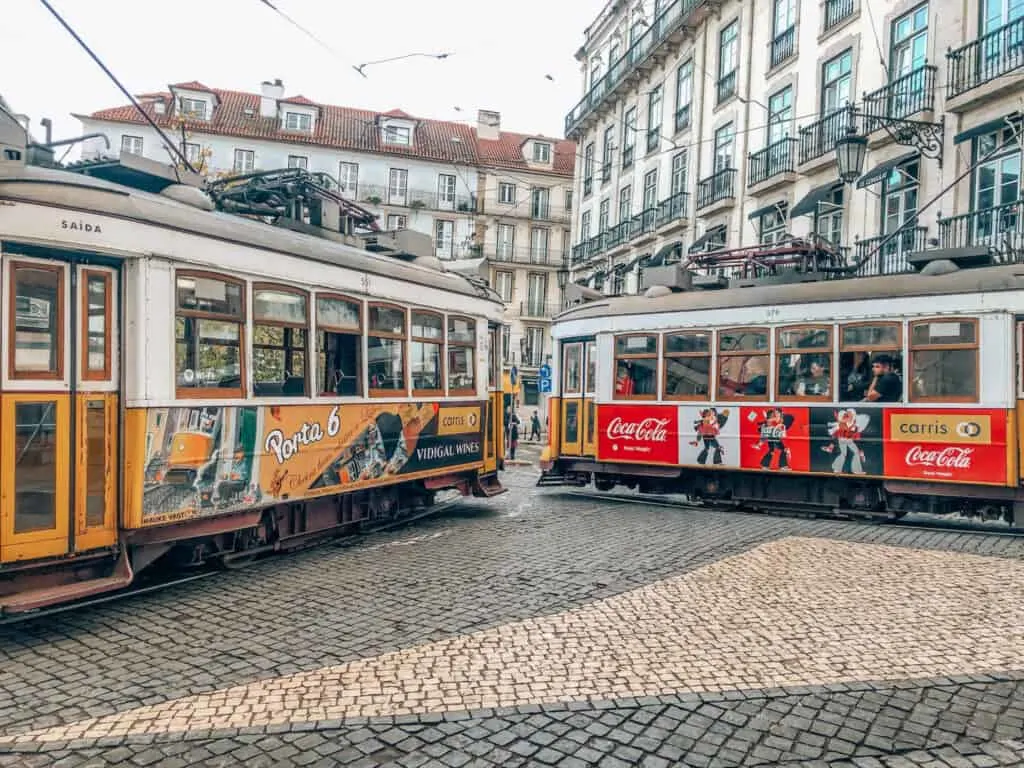
and the Bica – Lg. Calhariz Tram. The neighborhood is located on a steep hillside and is known for its iconic Bica Funicular, a popular tourist attraction that has been in operation since the late 1800s. The Largo Calhariz Tram is also located in Bica, which is a popular mode of transportation for locals and visitors alike.
The Bica Funicular is a steep railway that connects the upper and lower parts of the neighborhood. It is one of Lisbon’s oldest funiculars and is a popular tourist attraction, offering stunning views of the city and the Tagus River. The funicular operates daily and is an easy way to get around the neighborhood without having to climb the steep hills on foot.
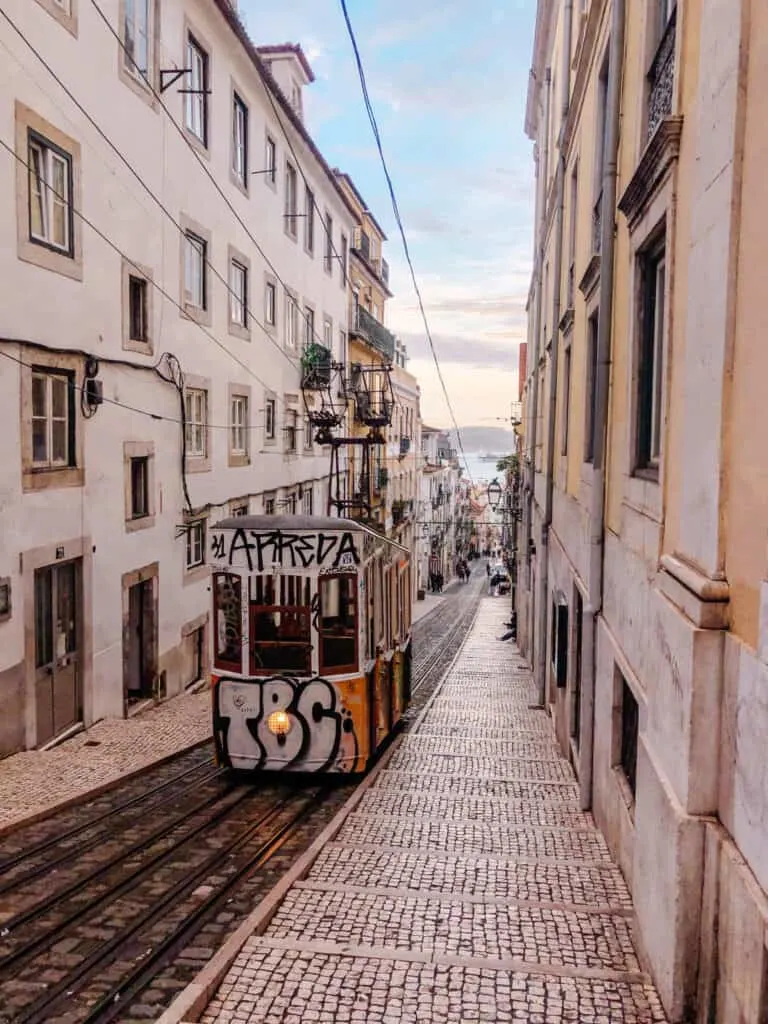
One thing to keep in mind when you are traveling to Lisbon is that the streets are very steep and you will either be walking straight up or down the whole time you’re there.
If you are looking for a good, cheap dinner, our favorite place was O Trevo which serves delicious pork sandwiches:

Chiado
We also did the Chiado neighborhood which is a vibrant and historic neighborhood located in the heart of Lisbon, Portugal. The neighborhood is known for its elegant architecture, upscale shops, and bustling cafes, making it a popular destination for tourists and locals alike.
The neighborhood has a rich history, having been a popular gathering place for intellectuals, writers, and artists in the late 19th and early 20th centuries. Many of the buildings in the area date back to this period and feature ornate facades and intricate detailing.
Chiado also has the world’s oldest bookstore called Livraria Bertrand which was founded in 1732.

You will also want to go to the Carmo Convent which is also known as the Convent of Our Lady of Mount Carmel, and is a historic site located in the heart of Lisbon, Portugal. The convent was founded in the 14th century and was one of the most important religious buildings in the city until it was partially destroyed in the earthquake of 1755.
Today, the ruins of the Carmo Convent stand as a haunting and beautiful reminder of Lisbon’s rich history. The walls and arches of the Gothic-style church still stand, while the roof and interior have been left open to the sky. The ruins have become a popular tourist attraction, and visitors can explore the site and learn about its history and significance.
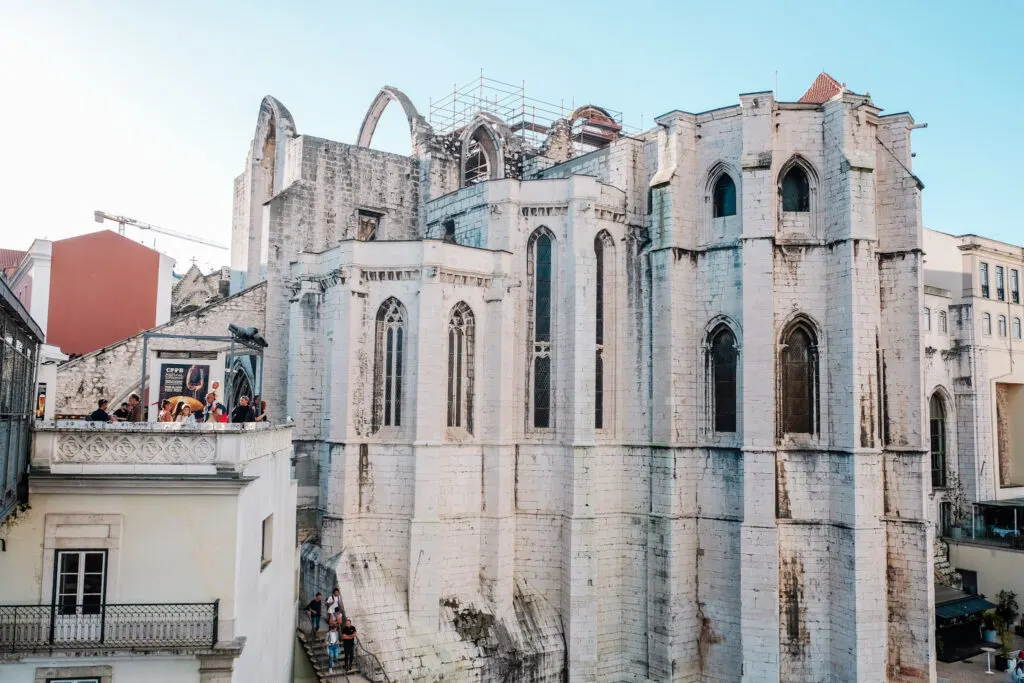
From the Carmo Convent, you can get to the top of the Santa Justa Lift for free without paying for a ticket!
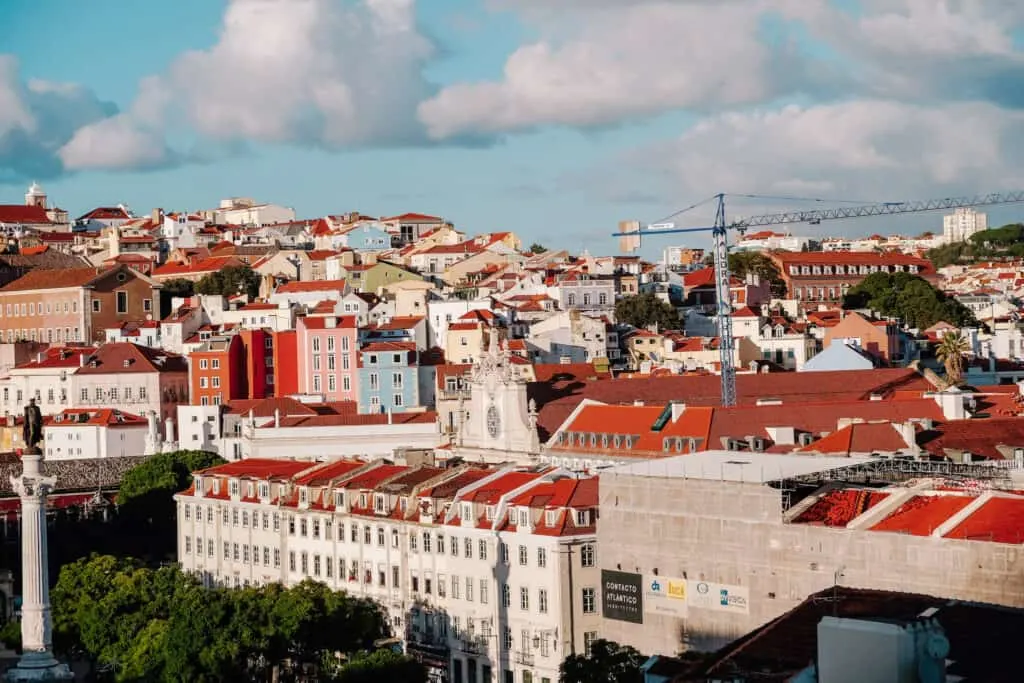
Cais do Sodré
We ended the day going to the Cais do Sodré neighborhood. It was not our favorite neighborhood that we went to on day one but it is where the Mercado da Ribeira (or Time Out Market) is, which is just an overpriced tourist market.
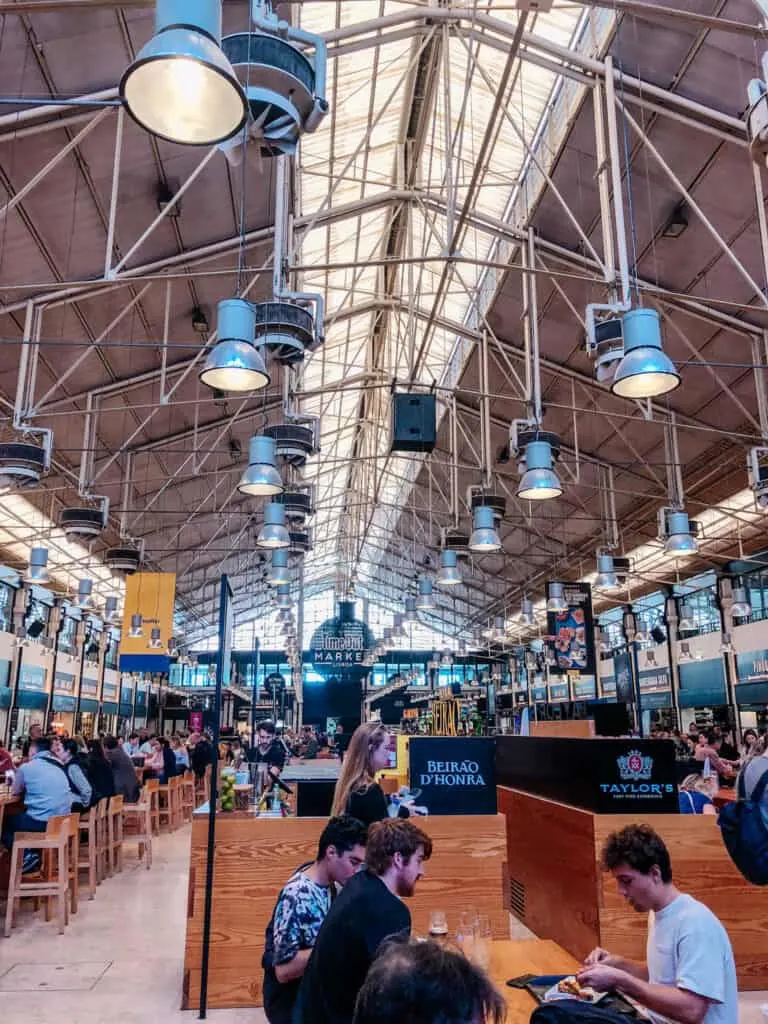
You can then end your day with a walk on the promenade and watch the sunset while enjoying a view of the Abril Bridge (or Ponte in Portugese), which is Portugal’s second longest suspension bridge:
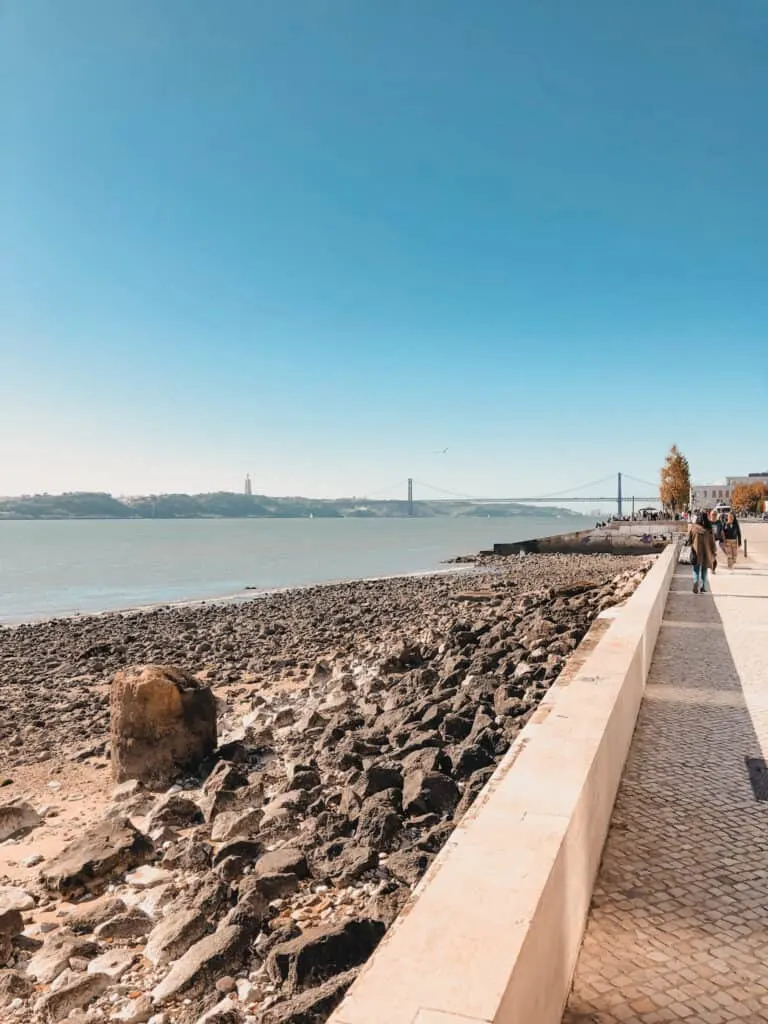
After that, we took the metro back to our hotel and that was our first day in Lisbon.
Day 2: Graça & Alfama & Baixa
Graça
We started out day two in the Graça neighborhood. Graça is a historic neighborhood located in the heart of Lisbon, Portugal.
The area is known for its stunning viewpoints, charming streets, and traditional architecture, making it a popular destination for tourists. The walk to the Viewpoint of Senhora do Monte was quite difficult but the view is definitely worth it!

Alfama
From there we walked to Alfama. Alfama is the oldest neighborhood in Lisbon, Portugal, and is known for its narrow cobblestone streets, colorful buildings, and historic architecture. The area is located on a hill overlooking the Tagus River, and offers stunning views of the city and the water.
Alfama is famous for its traditional Fado music, which originated in the area in the early 19th century. Visitors can enjoy live Fado performances at many of the bars and restaurants in the neighborhood, and can learn about the history and significance of this unique musical style.
This is where the beautiful Miradouro de Santa Luzia and Miradouro das Portas is.

From this viewpoint, it was a short walk down to Lisbon Tu e Eu which is one of the best cheap restaurants in Lisbon:

From there we went to the Lisbon Cathedral. The Lisbon Cathedral, also known as the Santa Maria Maior de Lisboa or the Sé de Lisboa, is a historic Roman Catholic cathedral located in the Alfama neighborhood of Lisbon, Portugal. The cathedral was built in the 12th century and is one of the oldest and most significant religious sites in the city:
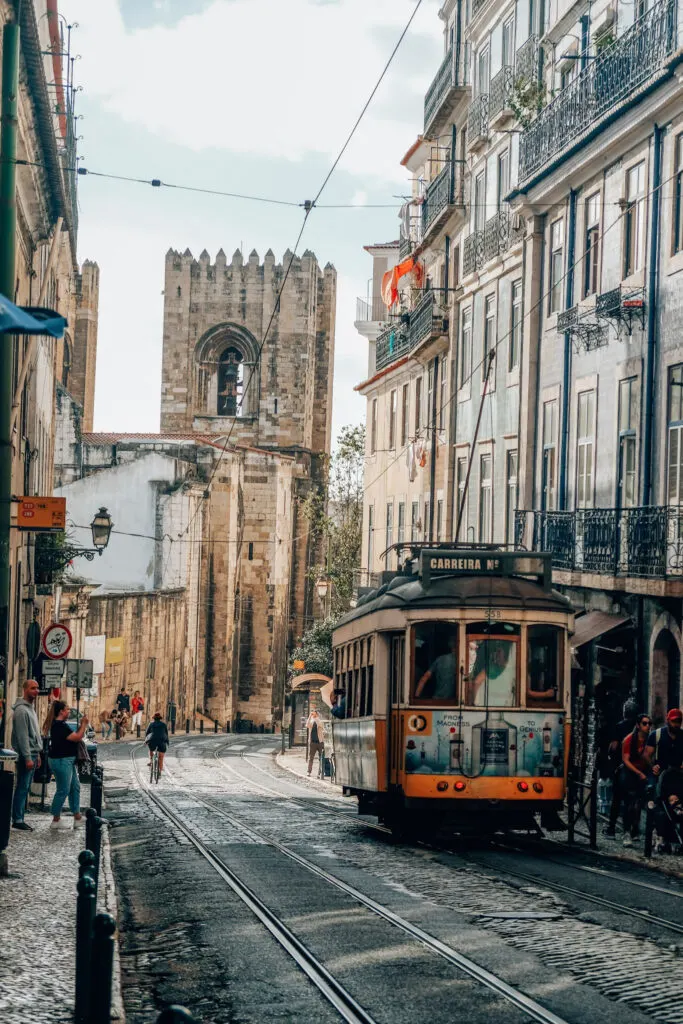
Then it was on to Arco da Rua Augusta. The Arco da Rua Augusta is a monumental arch located in the center of Lisbon, Portugal, at the end of Rua Augusta, one of the city’s main pedestrian streets. The arch was built to commemorate the rebuilding of the city after the 1755 earthquake, and its construction was completed in 1873.
The Arco da Rua Augusta is a stunning piece of architecture that blends classical and romantic styles. It stands 30 meters tall and features intricate stone carvings and sculptures, including allegories of the virtues and achievements of Portugal.
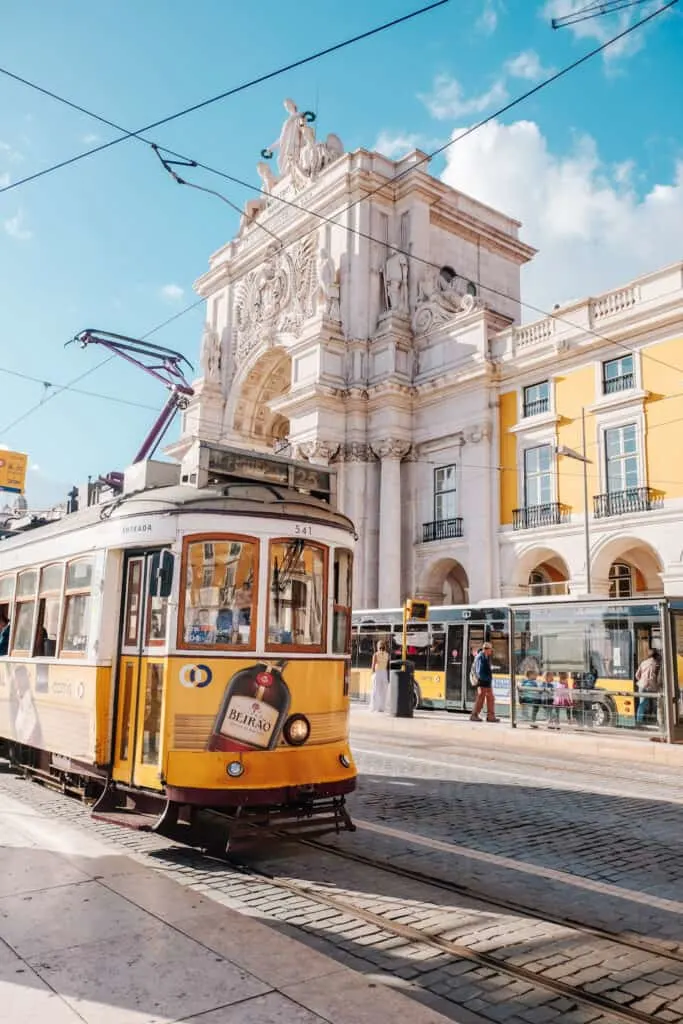
From here it was back to the hotel. We were exhausted and our feet were killing us but the views of the city were so worth it!
Day 3: Day Trip to Sintra
The next day we woke up bright and early and took an hour train to Sintra. Sintra is a magical city located just outside of Lisbon, Portugal. It is known for its stunning landscapes and cultural heritage.
It is home to extravagant palaces and romantic castles, such as the Pena Palace, Seteais Palace, and the Moorish Castle. These monuments were declared World Heritage Sites by UNESCO in 1995 due to their historical significance in Europe.
Sintra also offers breathtaking views from the Serra de Sintra mountain range, where you can take a delightful walk through trails of lush vegetation and exotic plants.
When we arrived in Sintra we found a local tourist bus called Scotturb. It costs 12.50 Euros per person for a 24-hour hop-on-hop-off pass. Don’t expect the bus times to be correct but it will eventually get you where you need to go for the cheapest price we found.
The first stop was at the Castelo dos Mouros. The Castelo dos Mouros, or the Castle of the Moors, is a medieval castle located in the town of Sintra, Portugal, just outside of Lisbon. The castle dates back to the 8th century and was originally built as a Moorish fortification to protect the area from invading armies.
The castle is perched on a hilltop, offering stunning views of the surrounding landscape, including the Sintra mountains, the town of Sintra, and the Atlantic Ocean. The castle’s stone walls and towers have been restored and visitors can explore the ruins, climb the towers, and walk along the battlements.
The castle has a rich history, having been occupied by the Moors, the Christians, and even being abandoned for centuries. It was restored in the 19th century and has been a popular tourist attraction ever since.
The Castelo dos Mouros is a fascinating destination for anyone interested in medieval history and architecture. Visitors can learn about the castle’s rich history, admire the stunning views, and explore the castle’s many towers, walls, and other features.
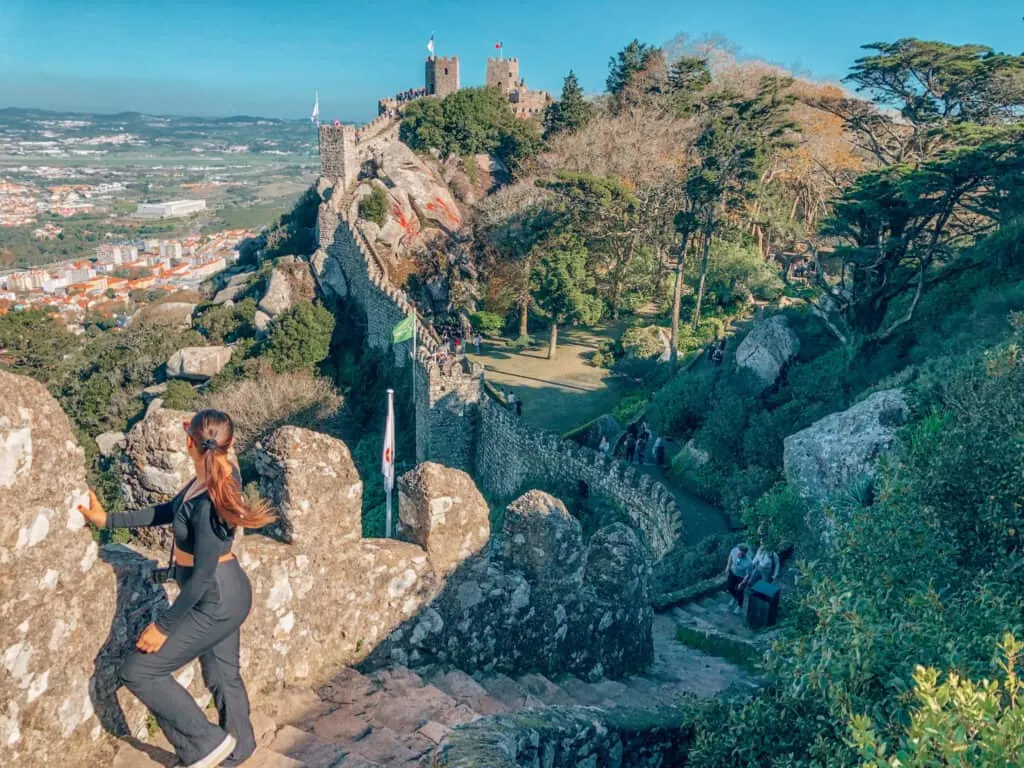
Then it was on to the most famous castle in Portugal, the National Palace of Pena. When we arrived there was a long line to get into the castle so we decided to walk to a viewpoint called High Cross, which gave us an amazing view of the castle from afar (my husband may have risked his life for this photo by climbing on the cross…).
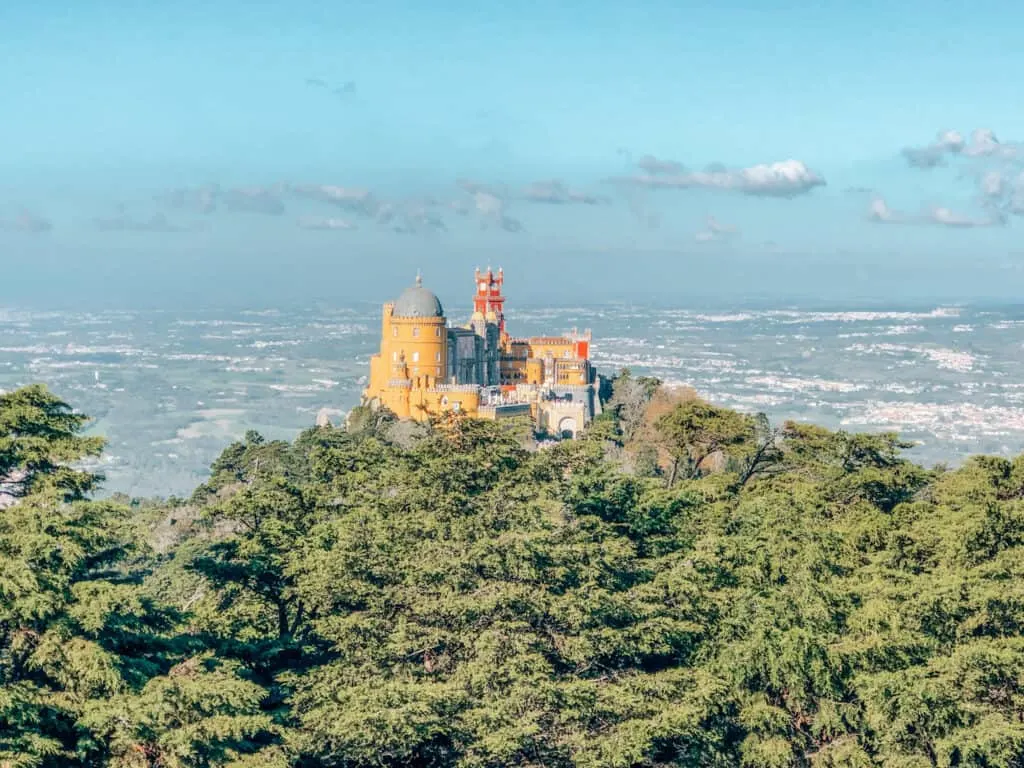
Then we walked back to the castle and got to go inside and it was amazing! The National Palace of Pena, or Palacio Nacional da Pena in Portuguese, is a UNESCO World Heritage Site located in Sintra, Portugal. The palace was built in the 19th century on the ruins of a medieval monastery by King Ferdinand II, who wanted to create a fairy tale palace that would reflect his romantic and artistic interests.
The palace is a striking example of Romanticism architecture, with its brightly colored exterior, turrets, and intricate stonework. The palace’s interior is just as impressive, with ornate decorations, paintings, and furnishings from the 19th century.
Visitors can explore the palace’s many rooms, including the King’s Chamber, the Music Room, and the Arab Room, which features intricate tile work and a stunning domed ceiling. The palace’s gardens are also a highlight, featuring lush greenery, fountains, and stunning views of the surrounding landscape.
The National Palace of Pena is a popular destination for tourists visiting Sintra and the Lisbon area. It is a must-see attraction for anyone interested in architecture, history, and art, and offers a unique glimpse into the Romanticism movement in Europe. With its stunning colors, ornate decorations, and lush gardens, the National Palace of Pena is a magical destination that will transport you back in time to the 19th century.

After this castle, we were exhausted and couldn’t walk another step. So we skipped the other four castles and took the bus back to Sintra and went back to Lisbon.
The two palaces that we would recommend going to (if you have the energy) are the Regaleira Palace and the Monserrate Palace.
The Regaleira Palace, also known as the Palace of Monteiro the Millionaire, is a magnificent palace located in Sintra, Portugal. The palace was built in the early 20th century by a wealthy Brazilian businessman named António Augusto Carvalho Monteiro, who wanted to create a unique and mystical retreat.
The palace is a stunning example of Gothic, Renaissance, and Manueline architecture, featuring intricate stonework, ornate decorations, and stunning gardens. The palace’s interior is just as impressive, with rooms adorned with frescoes, sculptures, and other works of art.
One of the main highlights of the Regaleira Palace is its gardens, which are filled with secret tunnels, grottoes, and fountains, as well as statues and other features that are inspired by Masonic and other esoteric symbols. Visitors can explore the gardens on foot and discover hidden pathways, terraces, and other surprises along the way.
The Regaleira Palace is a popular destination for tourists visiting Sintra and the Lisbon area. It is a must-see attraction for anyone interested in architecture, history, and esoteric symbols, and offers a unique glimpse into the imagination of a wealthy entrepreneur who wanted to create his own magical retreat. With its stunning architecture, intricate decorations, and mystical gardens, the Regaleira Palace is a true gem of Portugal’s cultural heritage.
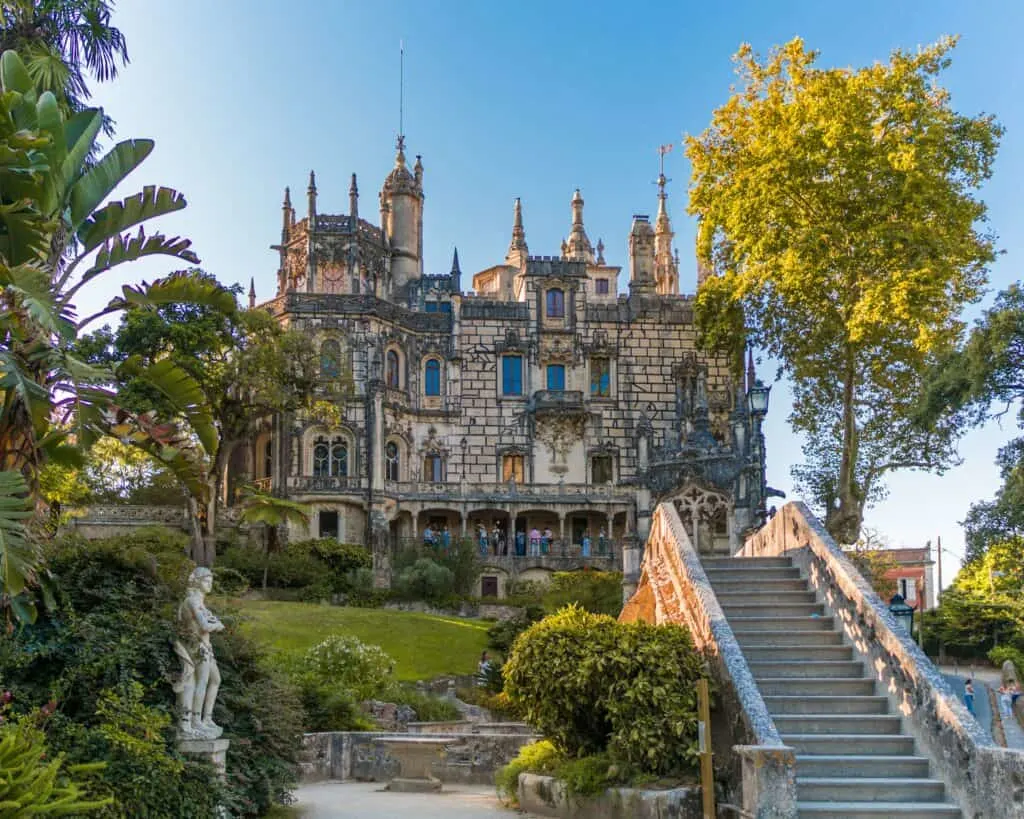
The Monserrate Palace is a beautiful palace located in Sintra, Portugal. It was built in the 19th century by Sir Francis Cook, a wealthy English businessman who fell in love with the region and decided to build his own retreat there.
The palace is a unique example of a mix of different architectural styles, including Gothic, Moorish, and Indian. The interior of the palace is equally impressive, featuring intricate decorations, beautiful furniture, and stunning works of art from different parts of the world.
One of the main highlights of the Monserrate Palace is its gardens, which are among the most beautiful in Portugal. The gardens are divided into different areas, each with its own theme and features. Visitors can explore a beautiful lake, a fern valley, a rose garden, and many other areas that offer stunning views of the surrounding landscape.
The Monserrate Palace is a popular destination for tourists visiting Sintra and the Lisbon area. It is a must-see attraction for anyone interested in architecture, history, and gardens, and offers a unique glimpse into the imagination of a wealthy entrepreneur who wanted to create his own paradise. With its stunning architecture, beautiful decorations, and magical gardens, the Monserrate Palace is a true gem of Portugal’s cultural heritage.

Day 4: Belém
On our last day in Lisbon, we had an early flight so we hopped on another train and went to the neighboring city of Belém.
Belem is a district in Lisbon, Portugal located near the mouth of the Tagus River. It is known for its iconic monuments, including the Tower of Belem and Jeronimos Monastery.
The Tower of Belem was built in the early 16th century and served as a ceremonial gateway to Lisbon’s harbor. It is now a UNESCO World Heritage Site.
The Jeronimos Monastery was built in 1502 and has been beautifully preserved throughout the centuries. It is most famous for its Manueline architecture style, which combines Gothic, Renaissance, and Moorish elements.
We got off at the Algés Train stop, which is only a 20-minute train from the Cais do Sodre stop, and walked to the Tower of Belém from there.
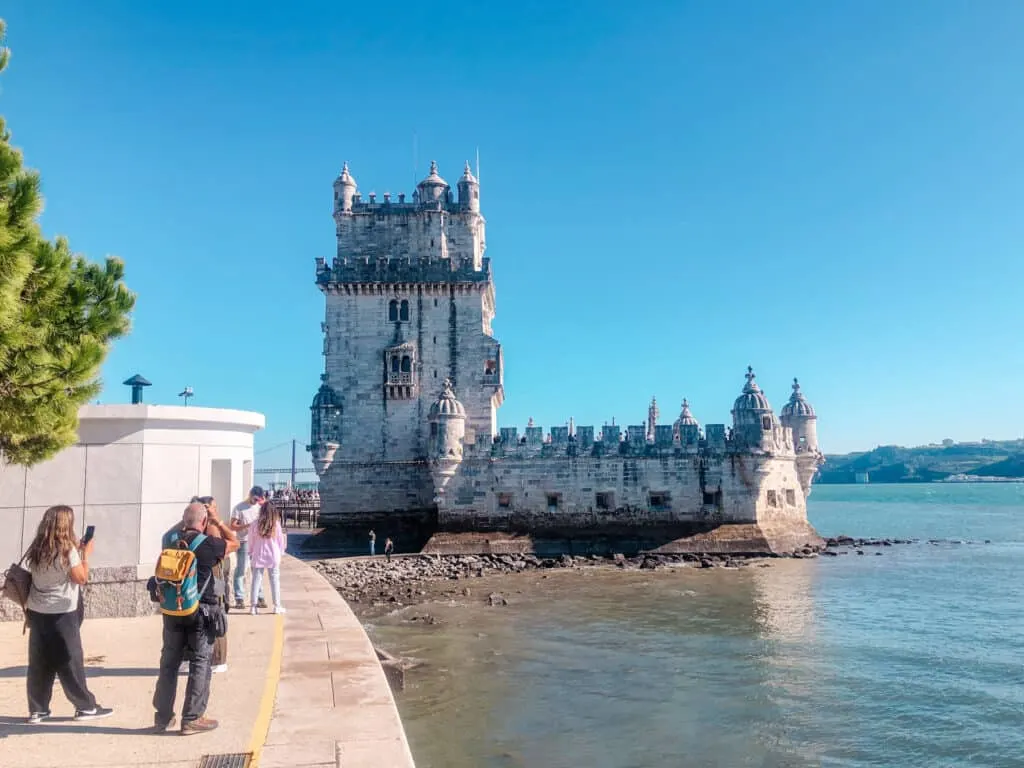
Then we walked to the Jerónimos Monastery. The Jerónimos Monastery, also known as the Hieronymites Monastery, is a magnificent 16th-century monastery located in the Belém neighborhood of Lisbon, Portugal. The monastery was commissioned by King Manuel I and was built to commemorate the Portuguese discoveries of the 15th and 16th centuries.
The monastery is a stunning example of Manueline architecture, with its intricate stonework and elaborate decorations. The interior of the monastery is equally impressive, featuring a beautiful nave, ornate chapels, and stunning works of art.
One of the main highlights of the Jerónimos Monastery is the tomb of Vasco da Gama, the famous Portuguese explorer who led the first European expedition to India. The tomb is located in the nave of the monastery and is decorated with beautiful sculptures and carvings.
The Jerónimos Monastery is also home to the National Archaeology Museum, which features a wide range of artifacts from prehistoric to modern times. Visitors can explore exhibits on everything from ancient Egypt to medieval Portugal to modern art.
The Jerónimos Monastery is a popular destination for tourists visiting Lisbon. It is a must-see attraction for anyone interested in architecture, history, and art, and offers a unique glimpse into Portugal’s rich cultural heritage. With its stunning architecture, beautiful decorations, and important historical significance, the Jerónimos Monastery is one of the most impressive sights in Portugal.

Then from there, we walked to the cute city center of Belém where we got pastel de nata from the top-rated Pastéis de Belém which has been making pastries since 1837!
The recipe for the pastéis de nata is said to date back to the 18th century when the monks of the nearby Jerónimos Monastery began making them to support themselves. The recipe was later sold to the owners of the Pastéis de Belém pastry shop, who have been making them ever since.
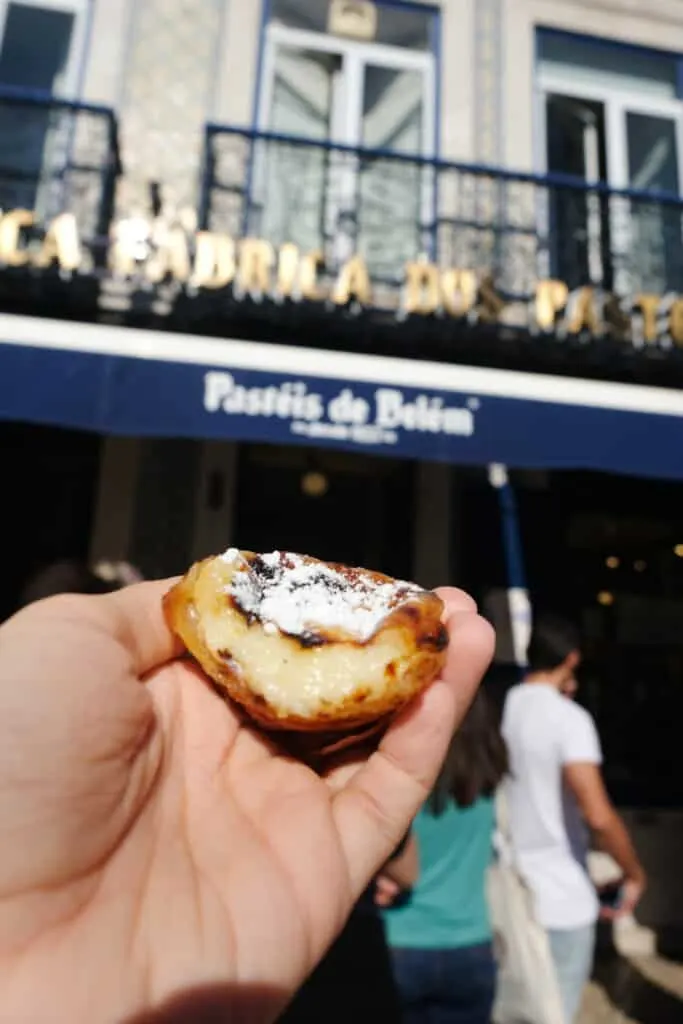
Then it was back on the train back to Lisbon to grab our luggage and make our EasyJet flight back to Nice!
Is 4 Days Enough Time in Lisbon?
4 days is definitely enough time to explore Lisbon and experience some of its culture, attractions, and monuments.
In four days you can visit all the iconic spots in the city, like Belem Tower and Jeronimos Monastery, take a day trip to Sintra or Cascais, explore the old town area of Alfama, and enjoy the delicious Portuguese cuisine.
You can also take advantage of all the nightlife activities in the city, from bars and clubs to live music venues. 4 days is just enough time to get a taste of Lisbon but not so long that you’ll be rushed or bored.
If you want to stay in Lisbon and not do any day trips then 3 days will be plenty of time to see the city.
How Many Days do I Need in Lisbon?
The amount of time you’ll need in Lisbon depends on what type of activities you plan to do. If you have limited time then we recommend at least three days, as this will allow you to experience the city’s main attractions and also explore some of its smaller neighborhoods.
However, if you want to spend more time discovering Lisbon’s hidden gems and exploring beyond the city center then you may want to consider spending up to a week in the capital.
And if you plan on doing all the major cities in Portugal, then it would be best to give yourself at least 10 days. Whatever your plans are, there’s something for everyone in Lisbon!
Where to Stay in Lisbon
When we stayed in Lisbon we stayed at the Holiday Inn Express Lisbon – Ave. Liberdade. It was in a great location right next to the metro stop. Plus, the view was amazing!
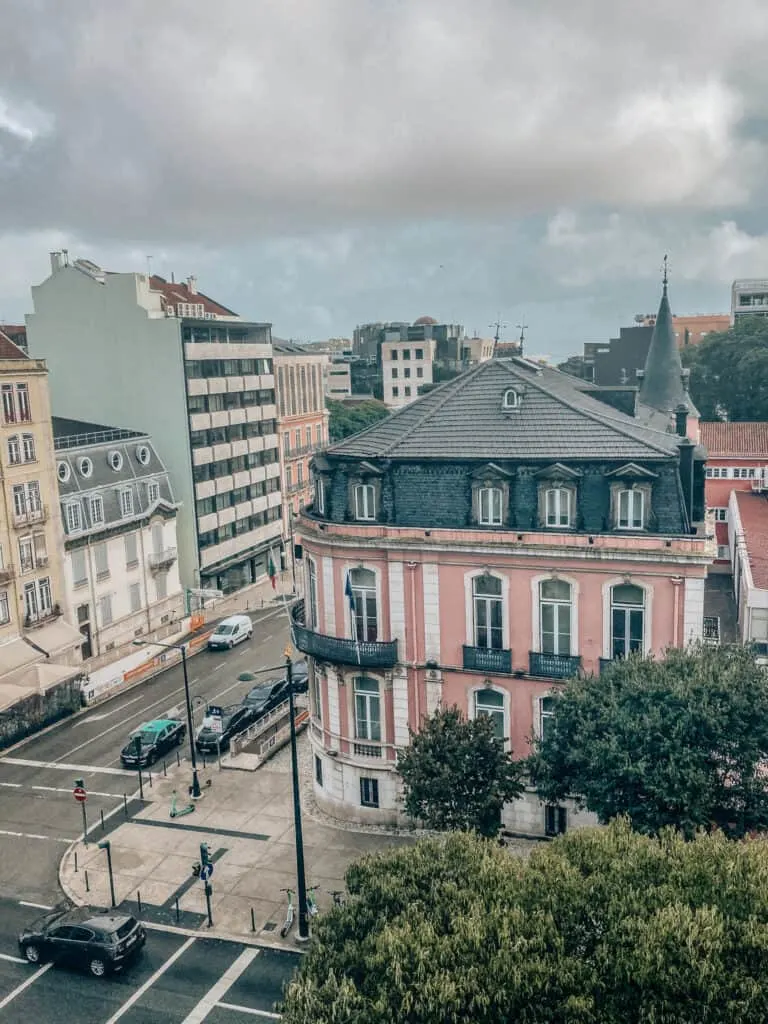
If you are looking for a hotel that is in the center of the action then check out the Hotel Santa Justa Lisboa. It is located in the heart of Lisbon’s downtown area and has easy access to all the main attractions. The hotel offers modern rooms with plenty of amenities.
For a budget option try the Safestay Lisbon Bairro Alto. It is a modern hostel located in the trendy Bairro Alto district. The hostel offers private rooms, shared dorms, and even family rooms with bunk beds. A dorm bed starts at around $30 per night.
How To Get To Lisbon
There are several ways to get to Lisbon, depending on where you are coming from and your preferred mode of transportation. Here are some common ways to get to Lisbon:
By plane: Lisbon has a major international airport, Lisbon Portela Airport, which is served by many airlines from around the world. From the airport, you can take a taxi, metro, or bus to get to the city center.
By train: Lisbon is connected to other major cities in Portugal and Europe by train. There are several daily trains from Porto, the second largest city in Portugal, and other cities in the country. There are also trains from Spain, including a direct train from Madrid.
By bus: There are many bus companies that offer services to Lisbon from other cities in Portugal and Europe. The main bus terminal in Lisbon is the Sete Rios bus station, which is located in the northwest part of the city.
By car: If you are driving to Lisbon, you can take the A1 highway from Porto, the A2 highway from the Algarve region in southern Portugal, or the A8 highway from Madrid, Spain. Keep in mind that traffic in Lisbon can be heavy, especially during rush hour.
Once you arrive in Lisbon, you can get around the city using public transportation, including the metro, buses, trams, and taxis. The city is also very walkable and has many pedestrian-friendly areas.
When we flew there we used EasyJet from Nice, France. EasyJet is a cheap option that flies all over Europe.
If you’re traveling within Portugal then buses are usually the cheapest and most convenient option. Taxis are also available at the airport but can be quite expensive if you’re traveling with a group.
If you plan on taking public transport around Lisbon then make sure to buy a ‘LisboaCard’ which is a rechargeable card that gives discounts on metro fares, bus tickets, and other transport services.
What to Eat in Lisbon
Lisbon is home to some amazing Portuguese cuisine. You must try the ‘bacalhau’ or salted codfish, which is one of the national dishes of Portugal.
Other Portuguese delicacies you should try are Francesinha (a type of sandwich made with beef, pork, ham, and cheese), Caldo Verde (a soup made with potatoes, kale, and caldo gallego), Pastel de Nata (custard tarts), and Arroz Doce (rice pudding).
Also, don’t forget to sample some of the local wines. In Lisbon, you can also find a variety of international food choices like Italian, Indian, Chinese, and more. So if you’re looking for something different then these may be worth checking out.
One of the things that we noticed about the restaurants in Lisbon is that they all felt like tourist restaurants. Like the kind of restaurants that have plastic food on display in front of them and have the waiters trying to persuade you to eat at their restaurants. So we tried to stick to only local restaurants like Lisbon Tu e Eu and O Trevo.
They also have food delivery options like Glovo which we used and it worked great. Glovo is a mobile app that allows users to order food, groceries, and other goods for delivery from local stores and restaurants. The app was founded in Barcelona in 2015 and has since expanded to over 20 countries, including Portugal, where it is popular in cities like Lisbon and Porto.
Using the Glovo app, users can browse through a variety of items available for delivery from local stores and restaurants. They can then place an order and track the delivery status in real-time. Glovo also offers a “Glovo Prime” subscription service, which provides users with free delivery on all orders for a monthly fee.
Glovo has become popular among consumers due to its convenience and ability to provide quick delivery of goods from local stores and restaurants. The app also provides job opportunities for delivery drivers, who can sign up to become Glovo couriers and earn money by delivering orders to customers.
What We Liked About Lisbon
Lisbon is a beautiful city with colorful, tile-covered buildings, amazing viewpoints, great pastries, and so much more! We enjoyed exploring the old town areas of Alfama and Mouraria, taking a day trip to Sintra, and savoring some delicious Portuguese cuisine.
Tiles

Lisbon tiles, also known as azulejos, are a type of decorative ceramic tile that is commonly found in Lisbon, Portugal. These tiles are an important part of the city’s cultural heritage and can be seen on the facades of buildings, churches, and other structures throughout the city.
The tradition of using azulejos in Portugal dates back to the 15th century when the Moors introduced the art of ceramic tile-making to the region. The tiles are typically decorated with geometric patterns, floral motifs, and scenes from history or mythology.
In Lisbon, many of the most famous examples of azulejos can be found on the facades of buildings in the historic districts of Alfama, Bairro Alto, and Chiado. One of the most iconic examples is the São Bento train station, which is adorned with over 20,000 tiles depicting scenes from Portuguese history.
The use of azulejos in Lisbon is not just decorative but also serves practical purposes. The tiles help to regulate the temperature inside buildings by providing insulation, and they also protect the walls from moisture.
Today, Lisbon tiles continue to be an important part of the city’s cultural identity, and many artisans still create and sell traditional ceramic tiles. Visitors to Lisbon can explore the city’s rich history and culture by admiring the beautiful azulejos that can be found throughout the city.
There are also plenty of outdoor activities to do like walking along the waterfront or going for a hike up in the mountains. Lisbon is also pretty affordable for a capital city in Europe and kind of is like the city of San Francisco back in America.
Hiking in Lisbon
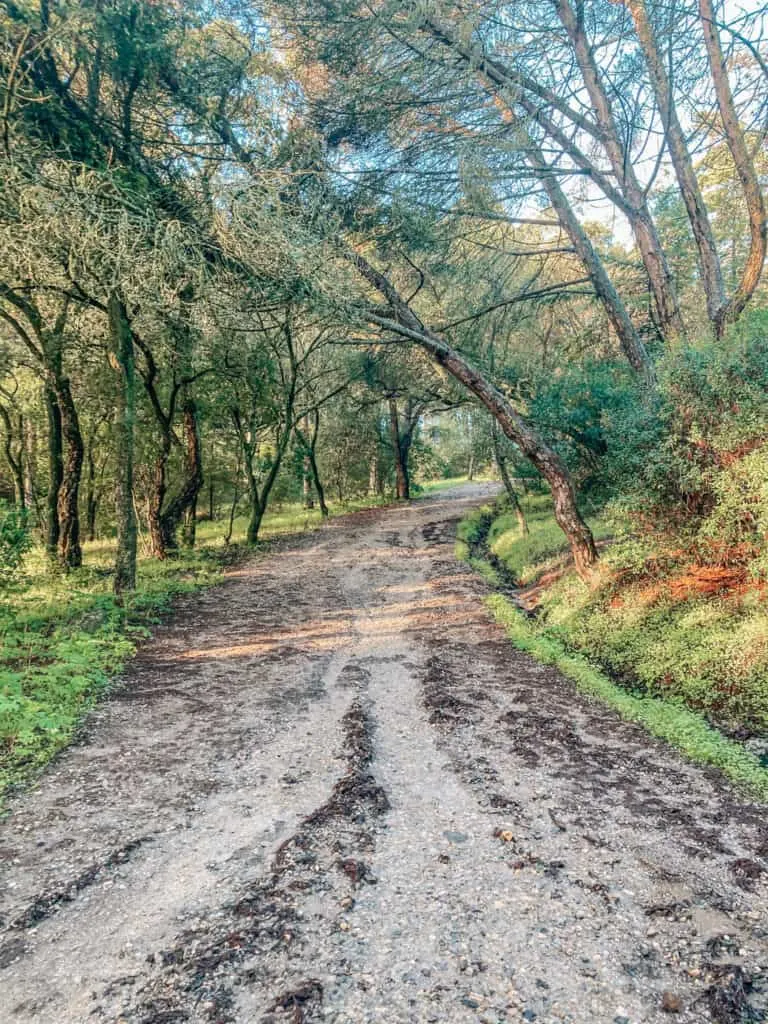
Parque Florestal de Monsanto, also known as Monsanto Forest Park, is a large public park located in Lisbon, Portugal. It is one of the largest green spaces in the city, covering an area of around 900 hectares.
The park was created in the 1930s as part of a plan to reforest the area surrounding Lisbon. Today, it is a popular destination for locals and tourists alike who come to enjoy its natural beauty and recreational opportunities.
The park is home to a wide variety of trees, plants, and wildlife, including cork oaks, stone pines, and foxes. It also has several walking and biking trails that offer stunning views of the city and the Tagus River. Other popular activities in the park include picnicking, birdwatching, and rock climbing.
In addition to its natural beauty, Parque Florestal de Monsanto is also home to several cultural and recreational attractions. These include a large sports complex, a skate park, and a children’s playground. There is also a restaurant and several kiosks throughout the park that serve refreshments and snacks.
Parque Florestal de Monsanto is a must-visit destination for anyone looking to escape the hustle and bustle of the city and enjoy some time in nature. Its stunning views, recreational opportunities, and cultural attractions make it a popular spot for locals and tourists alike.
We had a great time in Lisbon but would we recommend visiting Lisbon?…
What We Didn’t Like About Lisbon
Lisbon kind of felt like a city that got the soul sucked out of it. It was beautiful and we loved so much about it but we felt there was more wrong with it than there was right.
When we travel we love to walk as much as our feet can handle (and trust me that Lisbon put our feet to the test). We love to see the locals out and about and visit places that are filled with tourists and locals alike.
However, Lisbon didn’t have any places like this as far as we found. The closest we got to that feeling was when we took the metro.
We did visit in November so maybe it is different during the high season but Lisbon is supposed to be a capital city and always has locals in it, right?
So would I recommend that you visit Lisbon? Maybe. Would I personally go back to Lisbon? No.
3-Day Lisbon Itinerary
If you only have three days in Lisbon then just skip the day trip to Sintra. However, if you still want to do the day trip to Sintra here is how to do it.
Day 1
On your first day in Lisbon, spend the morning exploring the historic center. Start by visiting some of the city’s most iconic landmarks like Praça do Comércio or Rossio Square, then make your way up to Castelo de Sao Jorge for magnificent views of the city. As you explore, make sure to stop and sample some of the local delicacies like pastel de nata or bacalhau. Spend your afternoon wandering around Alfama’s narrow cobblestone streets, where you can also experience some amazing traditional Fado music.
Day 2
On your second day in Lisbon, visit one of Europe’s oldest bookstores, Livraria Bertrand. Afterward, wander around the old city center and explore some of its most impressive architecture like the Se Cathedral and Palacio da Pena. Make sure to leave time for lunch at one of the many small cafes in this part of town. Spend your afternoon exploring Lisbon’s modern side by strolling around Parque das Nações or visiting the MAAT Museum.
Day 3
On your last day in Lisbon, take a tour of one of the city’s most iconic palaces like Palácio da Pena or Palácio Nacional de Sintra. Afterward, visit Belem Tower and Jeronimos Monastery, both of which are UNESCO World Heritage Sites. In the evening, make your way to one of Lisbon’s many nightlife spots and enjoy some live music or traditional Portuguese cuisine.
Is 7 Days Too Long in Lisbon?
Yes, 7 days is too long in Lisbon. If you plan on taking day trips outside of the city, then 4-5 days is plenty. You can easily explore Lisbon in 3-4 days and use the rest of your time to visit nearby attractions like Sintra or Obidos.
But if you do decide to stay 7 days, there are still plenty of things to do – from tasting local delicacies to visiting historical monuments. With 7 days in Lisbon, you’ll be able to fully immerse yourself in the city and experience all that it has to offer.
Best Time to Visit Lisbon
The best time to visit Lisbon depends on your personal preferences and what you want to do during your trip. Here is a breakdown of the weather and tourist seasons in Lisbon:
High season (June to August): This is the busiest time of year in Lisbon, with many tourists visiting during the summer months. The weather is warm and sunny, with average temperatures ranging from 20-28°C (68-82°F). However, it can be quite crowded and prices for accommodations and flights tend to be higher.
Shoulder season (March to May, September to November): These are good times to visit Lisbon, as the weather is mild and there are fewer crowds. The average temperature during these months ranges from 15-22°C (59-72°F), and you may be able to find better deals on flights and accommodations.
Low season (December to February): This is the off-season in Lisbon, with fewer tourists and lower prices for accommodations and flights. The weather is cooler and rainier, with average temperatures ranging from 8-15°C (46-59°F). However, the city is still beautiful and there are many indoor attractions to visit.
Overall, the best time to visit Lisbon is during the shoulder season, from March to May or September to November, when the weather is mild and there are fewer crowds. However, if you don’t mind the crowds and higher prices, the summer months can be a great time to enjoy the city’s beaches and outdoor attractions.
More Europe Itineraries
- Naples To Capri Day Trip Itinerary
- Nice, France Day Itinerary
- Lyon Three-Day Itinerary
- Itinerary for the BEST European Christmas Markets
- The Ideal Itinerary for Two Days in London
- Is it Worth to Visit Zermatt?

Dayna Brockbank is a travel and language-learning blogger who has lived around the world but has now settled in Nice, France. She speaks 3 languages at varying levels of fluency: Spanish, Italian, and French, and graduated with a Bachelor’s in Spanish Education. She and her husband focus on making travel part of life by living cheaply and traveling on a budget.
